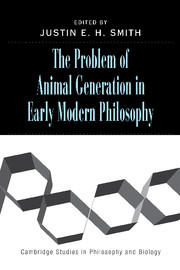Book contents
- Frontmatter
- Contents
- List of Contributors
- Introduction
- I THE DAWNING OF A NEW ERA
- II THE CARTESIAN PROGRAM
- III THE GASSENDIAN ALTERNATIVE
- 5 The Soul as Vehicle for Genetic Information: Gassendi's Account of Inheritance
- 6 Atoms and Minds in Walter Charleton's Theory of Animal Generation
- IV SECOND-WAVE MECHANISM AND THE RETURN OF ANIMAL SOULS, 1650–1700
- V BETWEEN EPIGENESIS AND PREEXISTENCE: THE DEBATE INTENSIFIES, 1700–1770
- VI KANT AND HIS CONTEMPORARIES ON DEVELOPMENT AND THE PROBLEM OF ORGANIZED MATTER
- VII KANT AND THE BEGINNINGS OF EVOLUTION
- Bibliography
- Index
6 - Atoms and Minds in Walter Charleton's Theory of Animal Generation
Published online by Cambridge University Press: 06 August 2009
- Frontmatter
- Contents
- List of Contributors
- Introduction
- I THE DAWNING OF A NEW ERA
- II THE CARTESIAN PROGRAM
- III THE GASSENDIAN ALTERNATIVE
- 5 The Soul as Vehicle for Genetic Information: Gassendi's Account of Inheritance
- 6 Atoms and Minds in Walter Charleton's Theory of Animal Generation
- IV SECOND-WAVE MECHANISM AND THE RETURN OF ANIMAL SOULS, 1650–1700
- V BETWEEN EPIGENESIS AND PREEXISTENCE: THE DEBATE INTENSIFIES, 1700–1770
- VI KANT AND HIS CONTEMPORARIES ON DEVELOPMENT AND THE PROBLEM OF ORGANIZED MATTER
- VII KANT AND THE BEGINNINGS OF EVOLUTION
- Bibliography
- Index
Summary
INTRODUCTION
The generation of animals, and especially the generation of human beings, is a recurrent theme in the work of the British physician and philosopher Walter Charleton (1619–1707). Based on an atomistic analysis of generation and corruption in his Physiologia Epicuro-Gassendo-Charletoniana (1654), he develops a purely mechanistic theory of animal generation in the Natural History of Nutrition, Life, and Voluntary Motion (1659). In later writings such as the Natural History of the Passions (1674), he expands the basic outlines of his views on animal generation into an atomistic account of emergent properties of higher animals. In addition, in works such as the Dissertatio Epistolica de ortu animae humanae (1659) and The Immortality of the Human Soul, Demonstrated by the Light of Nature (1659), he attempts to reconcile an atomistic view of the generation of the human organism with the Christian doctrine of an immortal human soul.
In recent years, two interpretations of the methodology behind Charleton's theory of animal generation have been influential. The first interpretation, put forth by Margaret Osler, ascribes to Charleton an empiricist methodology that, according to her view, is due to theological views that emphasize the role of God's will rather than the role of God's intellect. According to Osler, Charleton's voluntarist theology leads to an empiricist theory of knowledge. For example, she ascribes to him the view that some of the primary qualities of atoms can be known only by empirical methods.
- Type
- Chapter
- Information
- The Problem of Animal Generation in Early Modern Philosophy , pp. 124 - 144Publisher: Cambridge University PressPrint publication year: 2006



